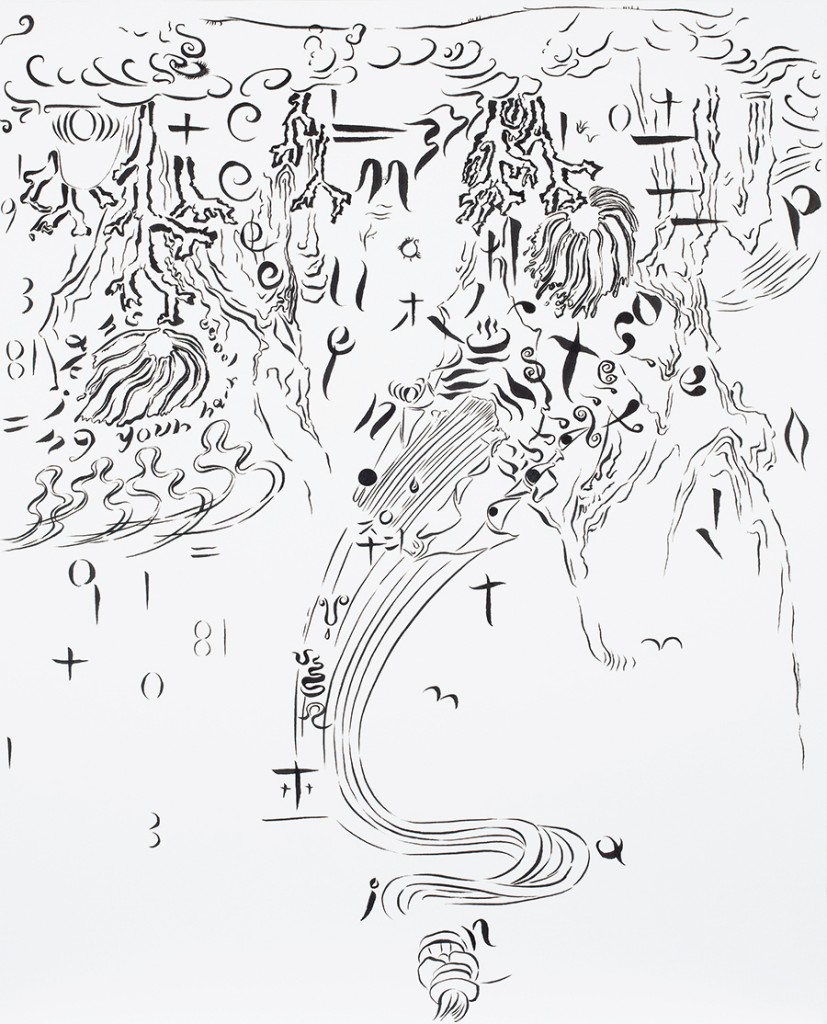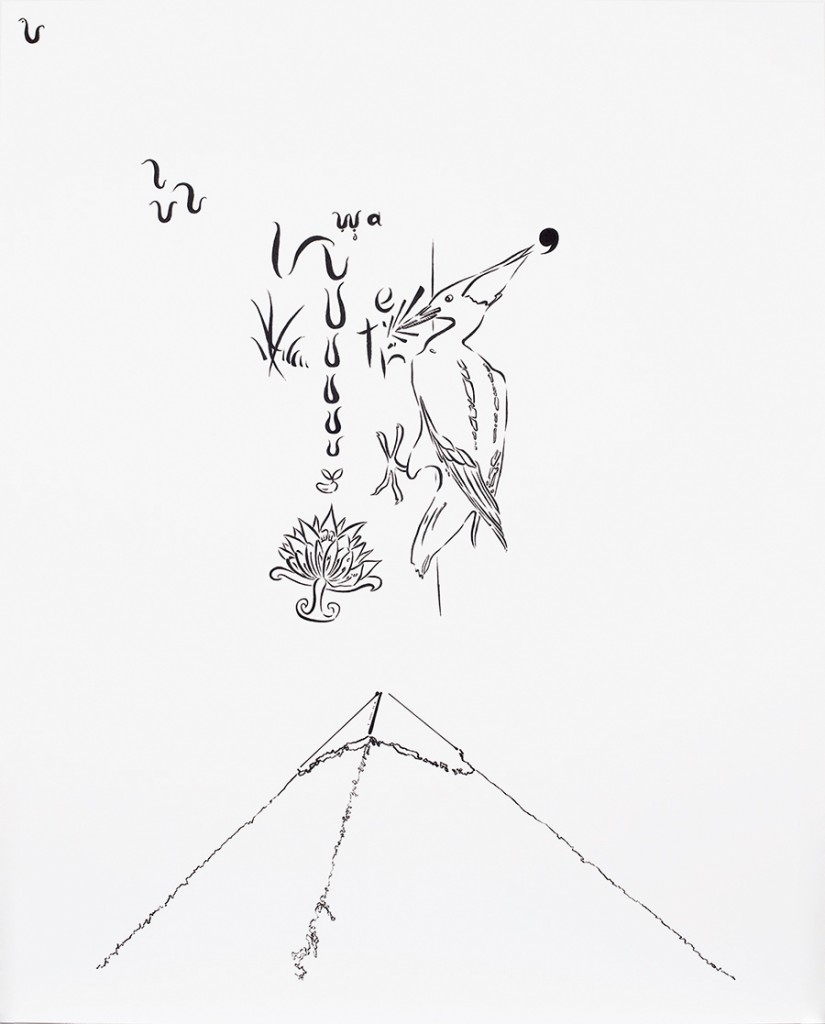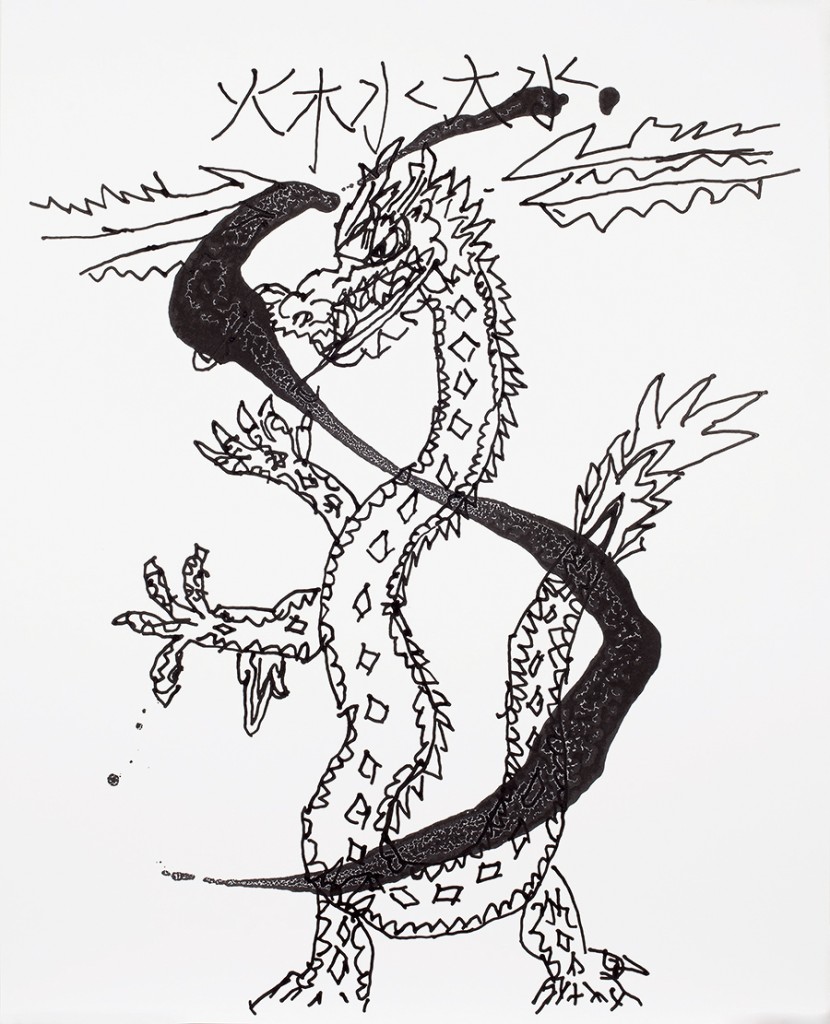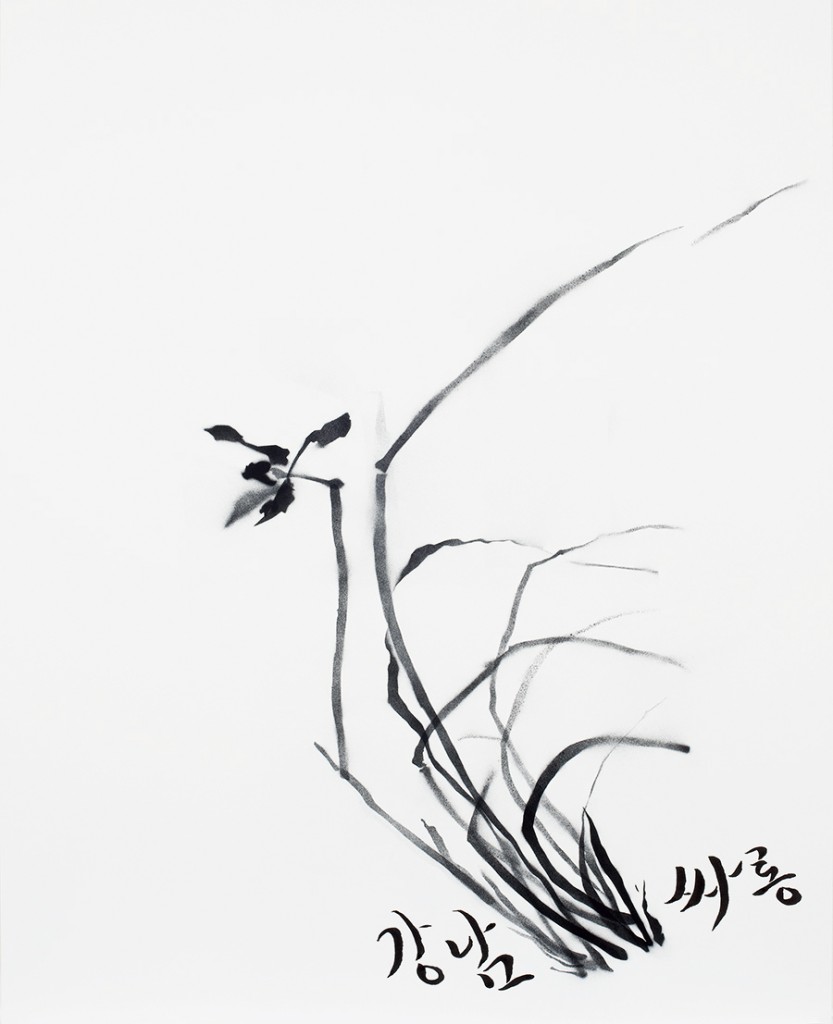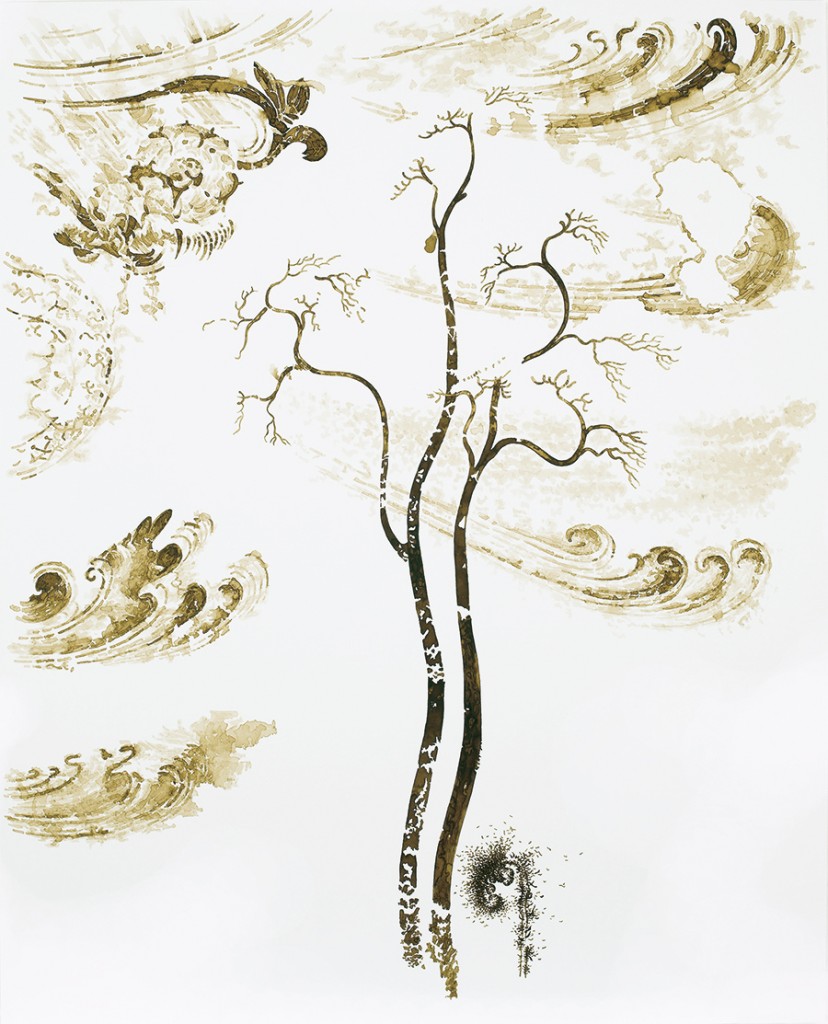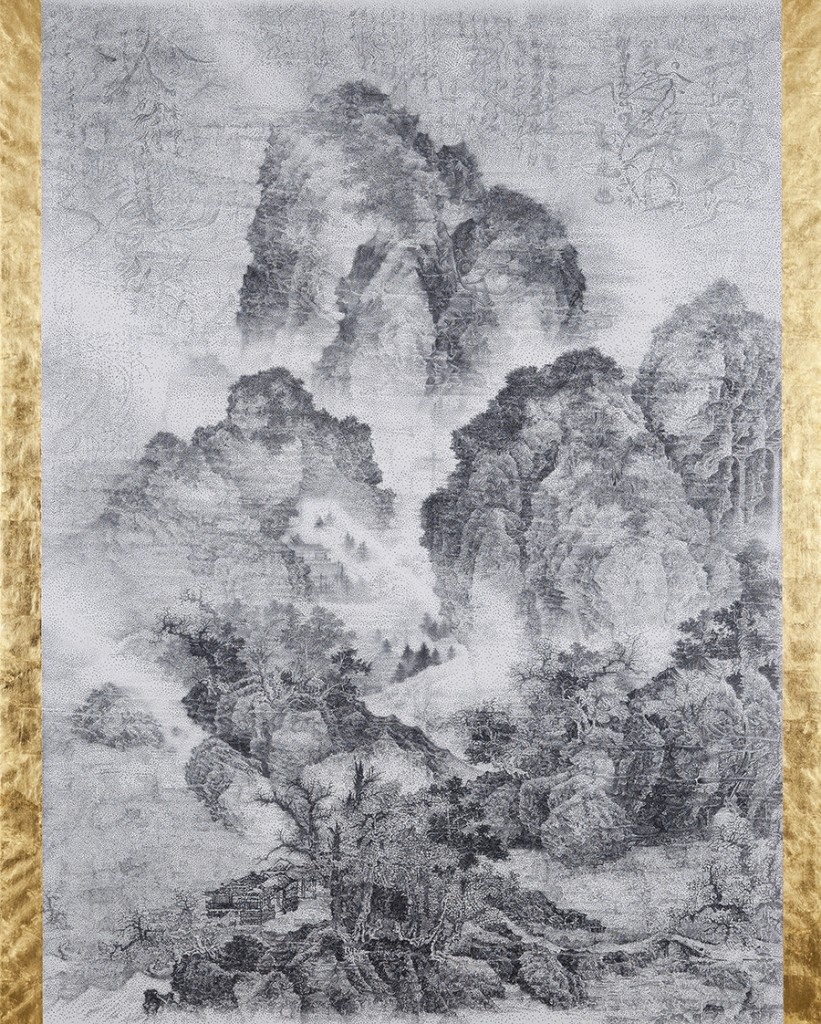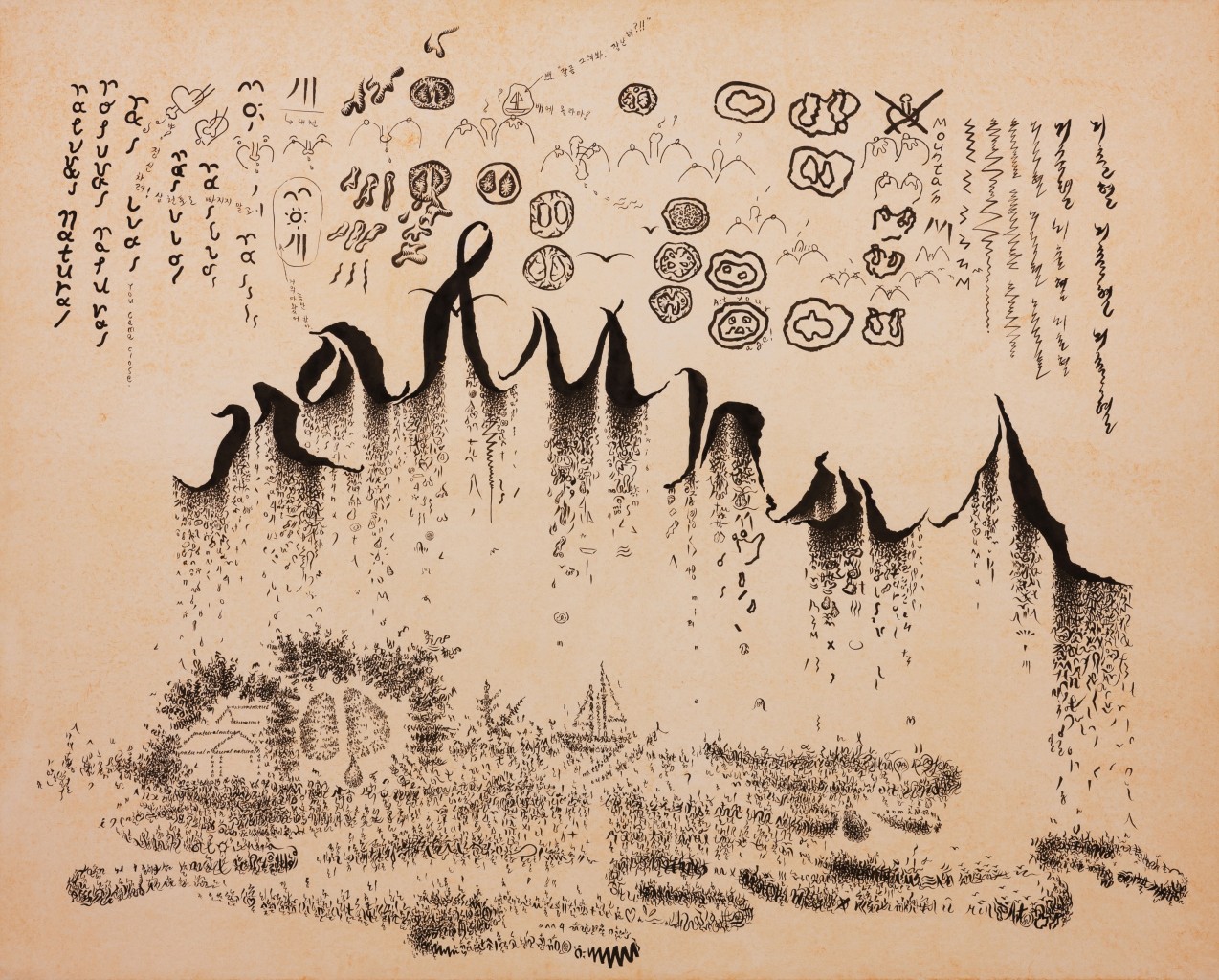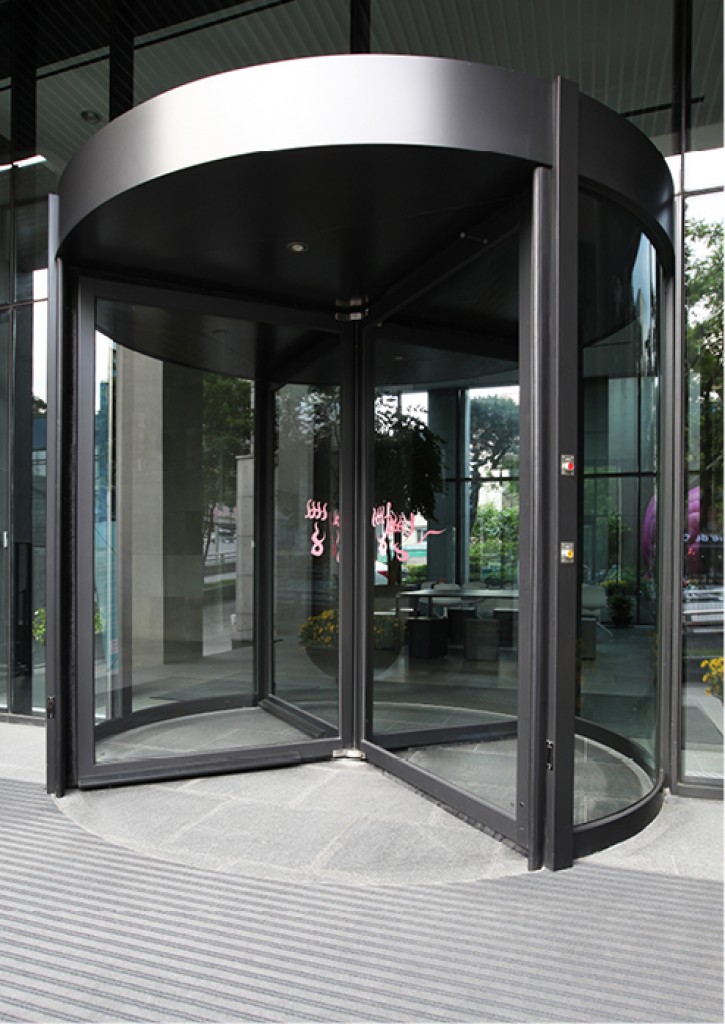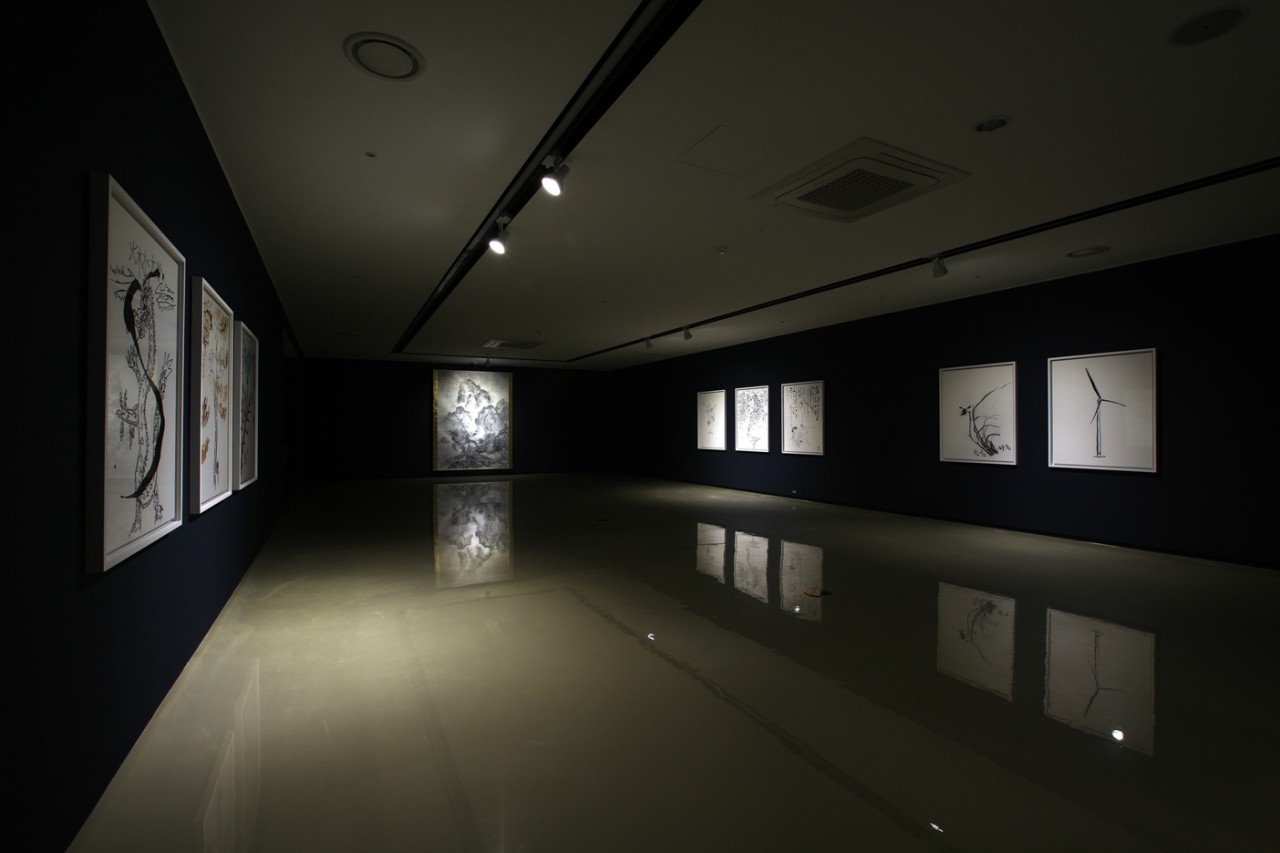Exhibitions
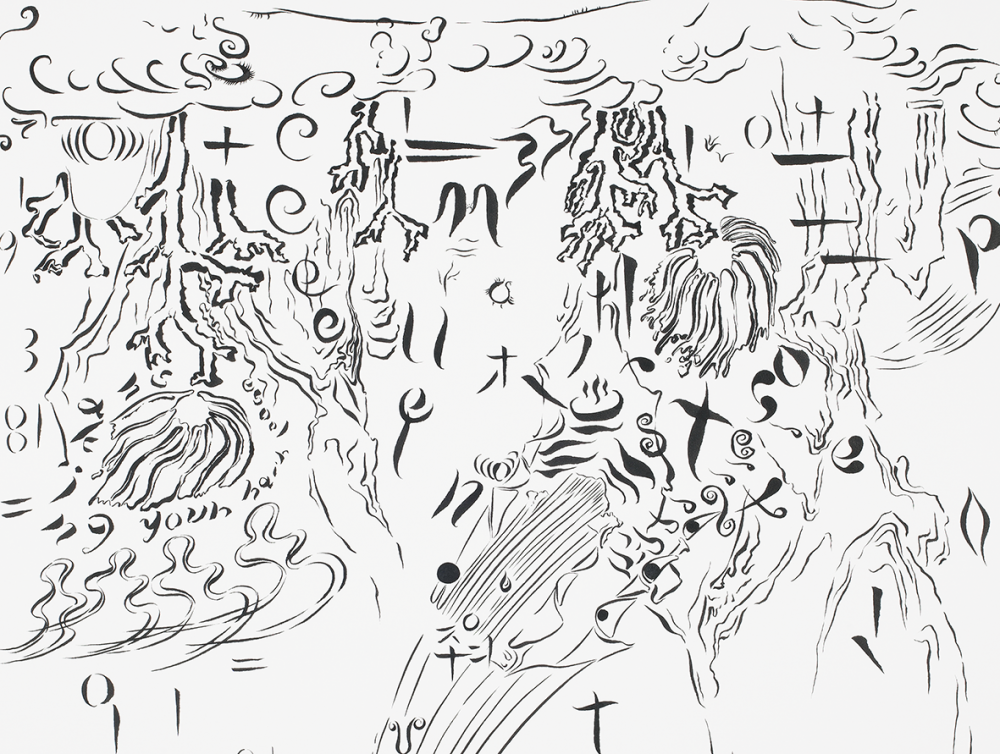
PERIGEE ARTIST #5 유승호
머리채를 뒤흔들어
2015.06.04. THU ~
2015.08.08. SAT
유치(幼稚)+찬란(燦爛)하게 노닐다
신승오(페리지갤러리 디렉터)
유승호는 문자와 이미지를 사용하여 다양한 작업을 해오고 있다. 이번 전시에서는 지금까지의 작업의 연장선상에 있는 신작들을 선보이고 있는 바 작가의 이전 작업들의 맥락들을 살펴보는 것이 현재의 유승호의 작업세계를 이해하는 데에 길잡이가 될 것이라 생각한다. 그의 작업은 특정 시리즈의 이름 보다는 전시타이틀로 많이 구분이 되며, 작품 제작의 시기도 동시 다발적인 성격을 띠기 때문에 시기적인 구분은 의미가 없다. 따라서 대표적인 몇 가지의 스타일로 분류하여 작업들을 살펴보기로 하자.
첫 번째로 먼저 그의 작업을 널리 알리게 된 대표적인 시리즈인 문자를 이용한 작업부터 시작해 보자. 문자 작업은 단어나 문장을 사용하여 어떤 풍경의 이미지나 상황을 표현하는 형태로 나타난다. 이 시리즈는 다시 두 가지의 스타일로 구분해 볼 수 있는데. 한가지는 아이들이나 코미디언이 하는 유치한 말 장난처럼 보이는 언어유희적인 성격이 두드러지는 작업이며, 또 다른 하나는 우리에게 익숙한 동서양의 명화 특히 동양의 산수화를 이용한 작업이다. 언어 유희적인 작업은 보통 의성어와 의태어이거나 외국어의 음차를 이용하며, 문자가 가지고 있는 의미를 뒤섞거나 이미지와의 연관성을 비틀어 사용함으로써 시각적으로도 그 의미적으로도 가벼우면서도 경쾌한 작업이다. 예를 들면 <뇌출혈>, <쉬>, <공> 등으로 제목이 지어진....
Childishly and Splendidly Frolicking
By Seung oh Shin, Perigee Gallery Director
YOO Seungho has created diverse works with characters and images. On display at this exhibition are his recent pieces that are an extension of his previous works. Reviewing his previous pieces and their context will be guides for grasping the current world of his art. His work is classified not by specific series but by exhibition titles, and any classification by period is of no significance because he has done several works simultaneously. His works can be reviewed and classified in a few typical styles.
The first style comes from the series using characters that helped make his work widely known. His character work represents images and situations by using words and sentences. This series can be divided into two styles: one exploits a play on words like a childish pun by children or comedians and the other appropriates both Eastern and Western masterpieces, especially Oriental landscape painting that is quite familiar to us. His work employing a play on words usually makes use of onomatopoeic and mimetic words and appropriations....
신승오(페리지갤러리 디렉터)
유승호는 문자와 이미지를 사용하여 다양한 작업을 해오고 있다. 이번 전시에서는 지금까지의 작업의 연장선상에 있는 신작들을 선보이고 있는 바 작가의 이전 작업들의 맥락들을 살펴보는 것이 현재의 유승호의 작업세계를 이해하는 데에 길잡이가 될 것이라 생각한다. 그의 작업은 특정 시리즈의 이름 보다는 전시타이틀로 많이 구분이 되며, 작품 제작의 시기도 동시 다발적인 성격을 띠기 때문에 시기적인 구분은 의미가 없다. 따라서 대표적인 몇 가지의 스타일로 분류하여 작업들을 살펴보기로 하자.
첫 번째로 먼저 그의 작업을 널리 알리게 된 대표적인 시리즈인 문자를 이용한 작업부터 시작해 보자. 문자 작업은 단어나 문장을 사용하여 어떤 풍경의 이미지나 상황을 표현하는 형태로 나타난다. 이 시리즈는 다시 두 가지의 스타일로 구분해 볼 수 있는데. 한가지는 아이들이나 코미디언이 하는 유치한 말 장난처럼 보이는 언어유희적인 성격이 두드러지는 작업이며, 또 다른 하나는 우리에게 익숙한 동서양의 명화 특히 동양의 산수화를 이용한 작업이다. 언어 유희적인 작업은 보통 의성어와 의태어이거나 외국어의 음차를 이용하며, 문자가 가지고 있는 의미를 뒤섞거나 이미지와의 연관성을 비틀어 사용함으로써 시각적으로도 그 의미적으로도 가벼우면서도 경쾌한 작업이다. 예를 들면 <뇌출혈>, <쉬>, <공> 등으로 제목이 지어진 작품들을 들 수 있겠다. ‘공’은 한자로 비어 있음을 뜻하는 동시에 영어로는 nothing이 되기도 ball이 되기도 한다. ‘뇌출혈’은 우리말로는 뇌혈관이 터져 의식을 잃은 상태를 나타내지만 영어 natural을 읽는 발음기호가 되기도 하고, ‘쉬’는 영어로 그녀이기도 오줌을 누는 의성어이기도 하다. 이렇게 다양한 의미를 가지고 텍스트의 사이를 넘나드는 것이 그의 작업 전반에 걸쳐 나타나는 작업의 특성이다. 이에 비하여 문자로 이루어진 산수화는 단어나 문장의 의미가 풍경과는 관계 없고, 만화에서 많이 사용되는 의성어와 의태어로 채워진다. 이런 기존에 이미 널리 알려진 이미지와 작가가 선태한 텍스트간의 비 연결성은 과거의 명화가 가진 의미를 부재하게 만들어 작가의 의도에 맞게 그것들이 가지고 있는 이상적이며 고졸한 풍경의 의미만을 취한다. 이런 두 가지의 작업은 특정한 상황과 의미로 파악할 수 없는 텍스트와 이미지와의 균열을 만들어 낸다.
두 번째는 점을 이용한 작업으로, 점이 텍스트와 이미지 등으로 변형되는 작업들이다. 점을 찍는 작업은 문자를 이용한 작업과 비슷한 시기에 나온 작업이다. ‘점’은 텍스트가 될지 이미지가 될지 모르는 가장 원초적인 시작점으로 무엇이 어떻게 나타날지 모르는 무한 가능성이 내재되어 있으면서도, 아직 아무것도 아닌 모호한 상태를 상징한다. 이렇게 작가는 점들을 이용하여 문자나 이미지 그리고 무엇인지 모를 형태들로 뒤섞는 작업을 보여준다. 이 작업들은 다시 이미지와 텍스트가 뒤엉키는 작업으로 이어지는데 점점 더 해체와 재 조합을 통한 변형을 해내거나 선형적으로 배치하는 방식으로 나타난다. 유승호는 형식적으로 복잡하고 모호한 작업들에서도 유행가 가사를 사용하거나 여전히 나타나는 말장난을 멈추지 않는다. 이러한 경향은 따라서 그의 작업의 전반에 지속적으로 나타나는 유쾌한 지점들로 보인다. 이와 같은 작가 자신의 머리 속에서 순간 떠오른 단어에서 시작하여 무의식적인 자아에 의해서 순차적으로 연상 되는 것들이 나타나는 작품들은 수수께끼 같이 모호하지만, 이에 대한 단서는 그의 작업 노트에서 찾을 수 있다.
‘나는 늘 자기세계에 대한 확신이나 중심이 없는 사람은 진정으로 자유로울 수 없다고 생각해요. 전 본능에 충실하려고 해요. 근데 그게 무척 어려워요. 이미 무엇인가가 의식의 세계를 많이 지배하고 있어서 그것들이 자꾸 방해해요.’ (작가노트 중에서)
이는 작가가 아무리 자유로워지려고 노력하고 본능에 의지하는 방식으로 자신의 내면의 본질을 찾아내려 시도하지만 외부의 영향이 자꾸 침투하여 뒤죽박죽이 되어버린다는 것이다. 그래서 그의 작업은 순서대로 도식화하는 과정을 보여주지만, 오히려 우리가 생각하는 것들은 순서대로 질서를 부여해서 정리하는 방식으로 파악할 수 없다는 반증의 의미가 되어버린다. 이후에 나타나는 ‘hypertext’ 작업에서는 이미지와 텍스트가 순차적으로 변형되어 가는 것이 아니라 하나처럼 유기적으로 밀착된 모습을 보여주고 있음을 알 수 있다. 이 작업들은 하이퍼텍스트의 의미인 개별 정보들을 링크를 이용해 유기적으로 연결시킴으로써 비연속적, 비선형적 체계를 가지고 여러 가지 실험들을 보여주는 것이 특징이다. 끊임없이 중심화, 탈중심화, 재중심화를 반복하는 하이퍼텍스트적인 해체는 기존의 고정된 텍스트의 의미에서 탈피하여 자유로운 구조를 가진다. 그러나 작가는 이러한 기존의 하이퍼텍스트의 개념과는 비슷하지만 본인만의 해석을 추가한다. 이는 기존의 하이퍼텍스트보다 더 원초적인 아직 형태도 갖추지 못한 무형의 의미에서부터 분열을 시작함으로써 유승호의 작업은 보다 더 완전한 자유로움을 추구하려고 시도하고 있다는 점이다. 따라서 작가는 이러한 텍스트와 이미지의 뒤섞인 방식을 사용하여 새로운 것을 억지로 만들어내기 보다는 자신의 머리 속에 담겨 있는 최대한 모든 것을 쏟아내어 그 안에서 자신의 근원과 본질을 구분해내고자 한다. 그리고 그 구분하는 과정 속에서 자연스럽게 나의 본질과 외부의 영향을 받은 것들을 자연스럽게 어우러져 재조합이 이루어지도록 하며, 이는 단순하면서도 복잡한 이미지들로 완성되어 나간다. 그렇다 보니 그의 작업은 단순한 평면 안에서 작업을 풀어나감에도 불구하고, 작품의 전반적인 분위기는 통통 튀어 어디로 튈지 모르는 고무공 같이 생기가 넘치고 활기차다.
이번 전시인 <머리채를 뒤흔들어>에서 보여지는 그의 작업들은 이전의 문자 작업들의 요소들과 ‘hypertext’시리즈들의 실험들이 접목되어 새로운 작업의 경향을 엿볼 수 있다. 일단 유승호의 신작들에는 무엇이 나타나는지 살펴보도록 하자. 신작 <죽이도록 주기도문>은 북송 초기 화가인 범관(范寬)의 웅장한 산수화를 주기도문으로 깨알같이 채운 문자산수화로 다시 만들어내고, 그림 주변에 금박까지 둘러서 화려하면서도 엄정(嚴淨)한 숭고미를 띤다. 이와 대조적으로 다른 작업들은 단순하면서도 간결한 형식으로 나타난다. 우선 눈에 띄는 이미지는 동양화에서 많이 그리는 난(蘭), 피라미드, 용, 신윤복 스타일의 춘화, 바람개비, 숫자, 고구려 벽화에 나오는 연꽃문양 등등이다. 그의 소재들은 시간과 공간을 넘나들며 나타난다. 또한 기법들도 제 각각이라 붓을 사용하거나, 종이를 뜯기도 하면서, 내용이나 소재, 형식, 기법들을 뒤섞어 단순한 외형적인 형태와는 다르게 복잡하게 다양한 요소들이 뒤죽박죽으로 종잡을 수가 없어 그 의미를 파악하기가 어렵다. 하지만 작가에게 있어서 이러한 소재나 작업방식들은 모두 숭고하고 절대적이며, 이상적인 대상으로 여겨진다. 어찌 보면 작가는 텍스트와 이미지가 서로에게 엉켜서 특정한 의미를 잃어버리는 그 순간이 가장 이상적이며 자유로운 바로 그 상태로 보는 것이다. 거기에다가 재료와 기법까지도 엉키게 하면서 기존의 단어나 이미지들이 가지고 있는 의미를 흩어버리고, 의미를 분절화 시키는 방식에서 한 단계 더 벗어나 모든 것이 시공간을 넘나들며 자유롭게 유영하도록 만들어내고 있다. 결국 단순하게 보이는 작업들 역시 그가 가장 수고를 들인 작업인 <죽이도록 주기도문>과 같은 의미를 지닌다. 이런 방식으로 그의 작품들은 아무것도 아니면서 또 그 자체로 모든 것이며, 해석이 가능할 것 같으면서도 불가능하다. 따라서 유승호의 작업에서 하나하나의 낱개의 의미를 찾으려고 노력하는 것은 무의미해진다. 그리고 이러한 지점들에서는 마치 이전의 작업에서 사용하였던 무엇이라 규정짓기 어려운 가장 근원적인 ‘점’이 연상된다.
그렇다면 유승호는 왜 이런 작업들을 해오고 있으며, 그의 선문답 같은 작업들 속에서 우리는 무엇을 찾아 내야 할 것인가? 지금까지 살펴본 그의 작업은 모두 틀을 벗어나서 자유롭게 그 경계를 넘나들면서 경계를 흐리게 만든다. 그리고 이러한 과정들을 통해 자신의 근원적인 요소들과 외부적인 요소들을 구분하고 이를 통해서 다시 재구성되어 새로운 의미들을 만들어 나가며, 그것들이 다시 모여 끊임없이 생성되는 모습을 보인다. 이와 같이 작품 속에서 그는 파편화된 이미지나 단어들을 그려내면서 우리들의 내면의 모습을 가감 없이 그대로 보여준다. 다시 말하면 자유롭게 하는 동시에 산산이 흩어지는 우리의 생각들을 시각화하려고 하는 것이다. 물론 이것은 유승호라는 한 개인의 생각에서 출발한 작업이지만 우리가 도달해야 할 근원과 중심에 대하여 이야기를 하고 있는 것이다. 결국은 그는 지금까지 다양한 실험적인 작업을 해오면서 자신이 가지고 있는 본질과 세상과의 융합을 통해 모든 것이 하나로 연결되어 ‘나’의 내부와 외부를 순환하는 과정을 통해 경계를 넘나드는 것이 아니라 그 경계조차도 사라지게 만들어 버리는 무경계의 하나의 숭고한 상태를 만들기 위한 과정으로 볼 수 있다. 그러나 그에게 이 숭고함은 고결함과는 다르며, 오히려 유치함에 가깝다. 이를 유추해볼 수 있는 것은 그가 만들어내는 모든 작품과 제목들에서 나타나는 유치함이며, 이는 그의 작업에서 중요한 부분 중에 하나인 작업에 대한 태도이다. 여태까지 살펴본 그의 작업은 모두 다르지만 공통적으로 나타나는 것은 활기차며, 유치하면서도 자유롭고, 가벼우면서 생기가 있는 한편으로는 이와 대조적인 면들인 작가로서의 진지함과 진중한 고민들이 내면에 깔려 있음을 찾아 볼 수 있다. 그의 작업은 이러한 작가 자신이 가지고 있는 다양한 성격들을 하나도 숨김이 없이 작업의 근간으로 삼으면서 시작되고 완성되는 것으로 보인다. 이는 작가가 이야기 하듯이 동양의 선비들이 예술에 대해 가지고 있었던 전통적인 수신(修身)의 의미와 문인화 화론(畵論)에서 나오는 자신의 마음이 그림이나 글씨에 투영된다고 하는, 그림을 대하는 태도와 자세와도 비슷하다. 따라서 낙서와도 같은 그의 작업은 즉흥적으로 빠르게 그려낸 것 같이 단순한 형태를 가지고 있지만, 사실은 하나 하나를 천천히 정성스럽게 아주 깨끗한 정신과 마음으로 집중해서 그려낸 온전히 자기 자신을 작업에 드러내는 것이다.
그렇다면 집중을 하는 방법은 어떨까? 그는 자기 자신의 작업을 대하는 태도를 ‘멍’이라 말하고 있다. 이는 아무 목적이나 의미 없이, 무엇에 대해서도 여념이 없이 생각과 마음을 모두 비운 상태로, 그저 멍하니 작업에 집중한다는 뜻이다. 다시 말해 멍은 의식을 비운 상태에서 솟아나오는 무의식에 집중해 의식과 무의식의 모든 것들을 하나로 아우르고, 순수한 형태와 숭고한 것에 다다르려는 그만의 예술에 대한 방법론을 함축한 것이다. 정리하자면 유승호는 이러한 ‘멍’을 통해서 정형화된 것과 자유로운 것들, 유치한 제목들 그리고 텍스트와 이미지를 넘나드는 모든 것들을 뒤섞어 숭고한 모습을 드러내는 작업을 하고 있다. 지금까지 살펴본 유승호의 작업의 바탕이 되는 힘은 결국 변화무쌍한 자기 자신을 온전히 작품에 담아 전달하고자 하는 그 과정에 있음을 알 수 있었다. 따라서 마지막으로 그의 작가노트에 있는 글로 마무리 짓고자 한다.
‘뿅~ 이죠. 뽕이기도 하구요. 그러다 뻥이 되다가 뻥~하고 터지는 거지요!’ (작가노트 중에서)
By Seung oh Shin, Perigee Gallery Director
YOO Seungho has created diverse works with characters and images. On display at this exhibition are his recent pieces that are an extension of his previous works. Reviewing his previous pieces and their context will be guides for grasping the current world of his art. His work is classified not by specific series but by exhibition titles, and any classification by period is of no significance because he has done several works simultaneously. His works can be reviewed and classified in a few typical styles.
The first style comes from the series using characters that helped make his work widely known. His character work represents images and situations by using words and sentences. This series can be divided into two styles: one exploits a play on words like a childish pun by children or comedians and the other appropriates both Eastern and Western masterpieces, especially Oriental landscape painting that is quite familiar to us. His work employing a play on words usually makes use of onomatopoeic and mimetic words and appropriations of foreign words’ pronunciations. This work is visually and semantically lighthearted and nimble due to the mixture of meanings characters retains and the twisted use of their associations with images. <Natural>, <Ball>, and <She> are examples of such works. “Gong” (공) in Korean means emptiness, nothingness, or ball. <Natural(뇌출혈)> in Korean refers to a cerebral hemorrhage, a state when one loses consciousness due to bleeding into the brain tissue, and coincidentally shares the pronunciation of the word “natural” in English. “She” in English refers to a woman but is also an onomatopoeic word in Korean for the sound of urination. In such ways YOO transcends text with diverse meanings which is the hallmark of his oeuvre. In comparison to this, his landscape painting composed of characters are filled with onomatopoeic and mimetic words often used in cartoons and the import of words and sentences adopted have nothing to do with the landscape itself. Any lack of connection between well-known images and texts the artist has chosen enables him to take only the meaning of the ideal and austere landscape found in past masterpieces as he intends. These two types of works give rise to cracks between texts and images that are not grasped from specific situations and meanings.
The second style morphs dots into texts and images and was produced in the same period as his character works. A dot is the starting point of both a text and an image and thus involves infinite possibilities to become something and stands for an ambiguous state that is not yet anything. With this in mind the artist creates and blends characters and images with something unknown using dots. This work continues the practice of entangling images and texts in a way that causes deformation through deconstruction and reconstruction and arranging them in a linear fashion. YOO continues to employ plays on words or the lyrics to popular songs even in formally complicated, equivocal works. This tendency has constantly appeared in his oeuvre as a hilarious point. His works triggered by what comes to mind and what he is reminded of with the unconscious self appear as ambiguous as a riddle. A clue to these works is found in his artist’s statement.
“I think one who is uncertain of his world and does not have his own subjectivity can hardly be free in a true sense. I try to go with my instinct but it’s really difficult. I have already been very much dominated by the conscious, which often hinders me from doing this.” (Excerpts from the artist’s statement)
The artist mentions that he does his best to be free and tries to explore the nature of his inner self in a way that depends on his instincts but things have become topsy-turvy due to external influences. His work displays a process of schematizing but it proves that we cannot grasp something in a way that would allow us to arrange what we think in order. In the series <Hypertext> that appears after this, YOO showcases organic contact between images and texts rather than their sequential alterations. As hypertext pages are organically interconnected by hyperlinks, this work is characterized by diverse experiments with discontinuous, nonlinear systems. A hypertext-like deconstruction that repeats centralization, decentralization, and recentralization relies on a free structure, departing from the fixed meaning of text. However, the artist adds his own interpretation of hypertext similar to the preexisting one. His work makes a foray into seeking a more complete freedom by starting division from a more elemental and formless meaning rather than established hypertext. The artist intends to draw out all of the ideas in his brain and distinguish his own source and nature from external factors in a way of intermingling text and image rather than unnaturally creating the new. In the process of such a distinction he makes his nature and things influenced by the external world naturally harmonized and recombined, completing simple yet complicated images. Although his work is unfolded in a simple plane, it is entirely vibrant and vigorous.
In his works on display at the exhibition <Shaking your Hair loose> we can catch a glimpse of the direction of his new work that grafts the elements of his previous character work onto experiments in the Hypertext series. In his recent work <The Lord`s Prayer, The Lost Player> he recreates a magnificent landscape painting by Fan Kuan, a Chinese landscape painter of the Song Dynasty, into a character landscape painting filled with characters that are as tiny as a grain of sesame. This painting appears flamboyant yet rigid and sublime with gilt applied to its edges. In contrast, other works appear in simple and concise form. The images standing out in his pieces include pyramids, dragons, Shin Yun-bok–esque obscene scenes, pinwheels, numbers, orchids often found in Oriental painting, and lotus flowers depicted in Goguryeo murals. His motifs flow over time and fly through space. The techniques he adopts vary from using brushes to tearing paper. The subject matter, form, and technique of the contents are mixed. As intricate, multifarious elements are tangled pell-mell despite succinct form, we can hardly grasp the meaning of his works. However, such motifs and work factures are all considered sublime, absolute, and ideal. Perhaps the artist can see the exact moment when text and image become tangled with each other and lose their specific meaning as the most ideal, liberal state. He makes it possible for everything to surpass space-time and navigate freely, escaping from the practice of segmenting meaning with preexisting words and images through an entanglement of even materials and techniques. His seemingly simple work has the same meaning as <The Lord`s Prayer, The Lost Player>, one of the pieces he gave his best effort in creating. In this sense his work is nothing and everything in itself and seems possible while impossible. It is thus meaningless to look for each individual’s meaning in YOO’s work. This aspect is associated with being hard to define and the simple dots he used in his previous works.
If this is the case, why has YOO practiced this type of art? What do we have to discover in his Seon (Zen) dialogue-like work? The pieces we have reviewed so far freely go beyond and blur the boundaries of everything, escaping preexisting frameworks. In this process he distinguishes his underlying elements from external factors, creating new meaning through reconstruction. He displays those elements that have constantly been recreated through congregation. He represents our inner aspects while illustrating fragmented images and words in his works. That is, he tries to free our thoughts and visualize them. Of course, his work derives from his own individual thoughts but he comments on the source and center we have to reach. After all, his work can be seen as a process of generating a lofty or boundless state rather than crossing the line between his intrinsic nature and the world as well as the inner self and the external world through his diverse experimental practices. To him, however, this sublimity differs from loftiness and rather verges on puerility. We can infer this from the fact that all of his works and their titles appear whimsical and his childish attitude is one of the significant elements of his art. His works reviewed above are different but manage to all be vibrant, puerile, liberal, lighthearted, and lively yet in a sense they are also imbued with his serious, heavy agony as an artist. His work seems anchored in his diverse personality. As he once mentioned, this resembles ancient scholars’ notion of art as a moral training and the theory of literary painting which states that a painter’s mind is reflected onto his painting and calligraphy. Although his works are composed of paring down images painted suddenly on a whim, they are in fact steadily rendered one by one with great care and pure spirit, revealing the artist himself as a whole.
If that is the case, then how does he manage to concentrate on his art? He refers to a vacant state as his attitude toward working. This means he concentrates on his work in a state of aimlessly emptying his mind. This state connotes his own artistic methodology to reach greatness and a pure form by orchestrating everything conscious and unconscious, mainly concentrating on the unconscious stemming from the state of emptying the conscious. In summary, YOO works on disclosing the sublime by blending standardized and liberal elements with childish titles, text, and images while in this vacant state. The force that forms his work after all derives from the process of conveying his ever-changing self through his creations. I would like to conclude with excerpts from his own statement:
“It is an ecstatic moment as if taking drugs. Like a balloon that bursts with a loud pop, it’s the moment of ecstasy!”



